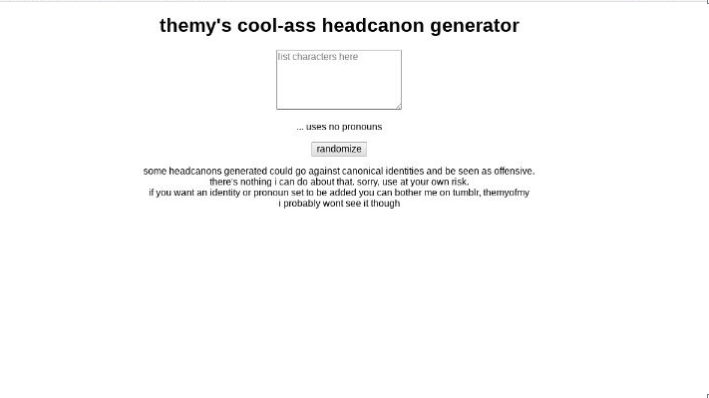Introducing the Concept
Introducing the headcanon generatorThe use of the headcanon generator begins with a brief introduction to the concept of headcanons which are personal beliefs or theories about parts of a fictional universe that are not stated in the material canon. This will help students appreciate how many ways there are to interpret texts, which is the true form of creativity in one's own thoughts that go along with a more developed understanding material.
Integrating into Lesson Plans
Developing a Character: Discover new facets to a character by generating headcanon. For example, they can type in known characteristics of a literary character and brainstorm these headcanons about who the person might be, why they act the way they do, or what they would do next. This task can be used for character analysis and building in creative writing, helping students become better descriptive writers.
Plot Development: Have teachers take the students through plotting other possible events or plots with a story to address what-if scholarly lands. This can mimic the structures of plot and it also shows the consequences of the narrative decisions on the students, therefore it deepens their skills as literary analysts and storytellers.
Theme and symbolism: This is great for having students create headcanons that delve deeper into the true themes or symbols of a text. These could also trigger conversations about theme development in literature and that symbols can be read in many different ways.
How to Nurture a Creative Writing Talent
It is a good resource for creative writing exercises, that's a free headcanon generator. The students use it to prompt story idea inspirations for stuff like fan fiction or other work based on all those random headcanons. It promotes creativity and students write make storylines and outside-of-the-box stories helps them develop their narrative writing, understanding and play with pacing and ensure character coherence.
Encouraging Critical Thinking
Checking headcanon ideas in the way I did, effectively just toying with what is and isn't possible, allows students to develop critical eye for the things they are thinking of, and in time properly evaluate them. Introducing debates or discussions around why these headcanons (including my own) might work with the story or shift the interpretation in this way the student is confronting headcanons as a reader as well as a writer.

Technology in Learning
This ability of headcanon generator is a very good example of real-life usage of technology in educational settings. Demonstrates to students how they can leverage digital tools to creatively deepen their understanding and engagement with the material they are learning.
Assessment Through Projects
Teachers can have students use the headcanon generator for projects to evaluate student comprehension. One example might be for the students to write a paper that elaborates on previous headcanons created about a character or plot, in such a way that it can be justified that it could fit into the story that is being worked with.
Leveraging feedback to learn
Include headcanon-generating and brainstorming feedback sessions with classmates. The process of submitting to and actioning feedback during peer review can improve the learning experience through collaborative critiquing, and mutual feedback further enables students to develop their abilities to analyse and create.
For ideas on how to incorporate this creative new gadget in your classroom, check out the headcanon generator. It provides a hands-on and interactive medium to implement theoretical understandings in real time, creating a more dynamic learning experience.
To sum up, incorporating a headcanon generator in pedagogical practices has the potential to transform the way we teach, finding new ways to interest students in the readings, improve their creative writing, and critical thinking levels. Through working on exercises, as well as discussing interactions, students learn how story works, what makes a strong concept, and how to write complex, likeable characters.